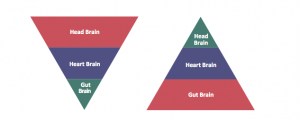
What is the relationship of the brains?
In the Western world we have revered the head-brain as the most influential followed by the heart and to a lesser extent the gut (figure on the left). According to Mark Chandlee Taylor, “if we were to illustrate the relative value given to the brains of the head, heart, and gut according to the traditional Western point of view, we would have an inverted pyramid.2

Taylor suggests a “realigned model (figure on the right) – one that draws on both anatomic and experiential analysis – proposes that a better foundation for our humanity is to right the pyramid, acknowledging our gut-brain as our strong and stable foundation, our heart-brain at ease, resting on the wisdom of the gut, and our head-brain at the top, in a smaller, less dominant role than in the old model.2
What are the core competencies of each brain?
Each of our three brains is best suited to a specific role:
- Gut Brain: “Is your core identity and contains the deepest levels of the You rely on your gut often for quick decision-making; that fight or flight response (safety or risk). You may find courage, fear, action, and grit down there.4
- Heart Brain: “Is used mostly for processing emotions (joy, jealousy, anger, hate, love, lust, compassion, empathy). It helps you to discover what is most important to you in life, priorities, and It helps you to connect or disconnect with others based on similarities or differences in those values.3 The heart brain also has an electromagnetic field that envelops every cell of the body and extends out several feet in all directions into space. This field operates just below the level of consciousness and has the capacity to affect individuals around us. What this means to coaching is that by accessing the heart brain we can subtly influence our client.
- Head Brain: “Is primarily used for cognitive perception and pattern You use your head to reason, to analyze and to synthesize information that comes in. One way your head makes meaning of things is through language (verbal, written, body), telling stories and using metaphors.3 The head brain uses 80% of the energy of the body – by giving the brain a rest we can increase the energy available for the other two brains and the rest of the body.
















